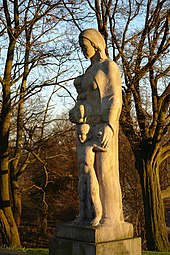Cenotaph for the people of Bremen who died in the First World War
The memorial for the people of Bremen who fell in 1914–1918 , those who fell in the Gerstenberg division and the Caspari Freikorps is on the Altmannhöhe on the eastern edge of the Bremen ramparts . It was designed in 1933 by the sculptor Ernst Gorsemann and the landscape architect Heinrich Wiepking-Jürgensmann and inaugurated in 1935.
The memorial consists of a curtain wall, which is covered on the inside with around 10,000 name stones made of clinker bricks in different colors. An altar-like stone block in the central axis, which can also be characterized as a cenotaph , gives the complex a decidedly sacred character. Opposite it, but outside the three-quarter circle, is the sculpture of a mother with children.
history
In March 1933, the Bremen Senate was forced to resign by the National Socialists. In September the NS-compliant new Senate decided to tackle the memorial project. In December, the commissioned sculptor Gorsemann from Bremen and the landscape architect Heinrich Friedrich Wiepking-Jürgensmann, who works in Berlin and Cologne, submitted a design. The citizens of Bremen were asked to donate. The solemn inauguration in the presence of senior military officials took place on October 13, 1935, in 1936 Gorsemann added the stone sculpture Mother and Children , which was damaged shortly before the end of the war.
At the same time, a memorial project called for by the volunteer corps veterans in the shape of the dying youth was realized by Herbert Kubica in downtown Bremen.
A new version of the mother figure, begun in 1945 and on which Gorsemann had worked until his death in 1960, was set up in 1963. "He made the only significant change compared to the first sculpture in the design of the head of the 'mother', to whom he caressed in the second version, gave suffering facial features and replaced her 'German' hairstyle, corresponding to the National Socialist image of women, with a simple cloth" (Mielsch). Apart from some damage to the name stones in the war and post-war period and the deliberate removal of six National Socialists who died in the power struggles before 1933, the complex has been preserved unchanged, including the tribute to those who died in the suppression of the Bremen Soviet Republic .
Therefore right-wing groups repeatedly used the facility for meetings and rallies for militaristic and racist goals, after which the wall was closed by a gate.
Inscriptions
A poem by Conrad Ferdinand Meyer all around the name stones :
“We dead + we dead are greater armies than you on earth + than you on the sea + we plowed the field with patient deeds + you swing the sickles and cut the seeds + and what we finish and what we started + that still fills up there the rushing fountains + and all our loves and hates and struggles + that is still knocking up there in mortal veins + and what we found of valid sentences + all earthly walk remains bound to it + and our tones, structures + poems fight for the laurel in shining ones Light + we are still looking for the human goals + therefore honor and sacrifice + because ours are many "
On the right on the ring wall: "In the struggle for the liberation of Bremen, Caspari and the Gerstenberg volunteer division fell on February 4, 1919" (the names follow).
On the "altar": "1914–1918 / 10,000 men and youths moved from this city in war and death / Nobody has greater love than that he gives his life for his friends."
literature
- Beate Mielsch: Monuments, open sculptures, fountains in Bremen 1800–1945. Bremen 1980, pp. 43, 57, figs. 83–85.
- Stadtgrün Bremen (Ed.): Between desire and stroll, 200 years of Bremen ramparts. Bremen, 2002, pp. 219-222.
- Peter Kuckuk : The “Memorial” for the soldiers who died in Bremen during the First World War on Altmannshöhe in: Wiltrud Ulrike Drechsel: History in public space. Monuments in Bremen between 1435 and 2001 , Bremen: Donat, 2011, pp. 84–101.
Web links
- k: art in public space bremen
- Monument database of the State Office for Monument Preservation
- List of 10,000 fallen in World War I Altmannshöhe War Memorial
Individual evidence
- ↑ On the connections between Gorsemann, Wiepking and the Bremen horticultural director Richard Hohmann see Kai Artinger: "Germanisches Waldrind" and Rhododrendren. The history of Bremen's most famous open-air sculpture and the rhododendron park during National Socialism, in: Workers' Movement and Social History, Issue 26, Bremen 2012, p. 56 ff.
- ↑ On this competitive situation, see the work by Frank Hethey: "Your is not thought of by a memorial so far", The project of a Bremen Freikorps monument - the way to the statue of young people by Herbert Kubica: (digital only) ( Memento of the original from December 16, 2014 on the Internet Archive ) Info: The archive link was inserted automatically and has not yet been checked. Please check the original and archive link according to the instructions and then remove this notice. , Chapter 2.
- ↑ Mielsch, p. 43
- ↑ Press release of the Bremen Peace Forum
- ↑ Joh 15,13 EU : With this quote from the Gospel of John, the church was unopposed, the death of the soldier was compared with the crucifixion of Christ.
Coordinates: 53 ° 4 ′ 18.8 " N , 8 ° 48 ′ 46" E

